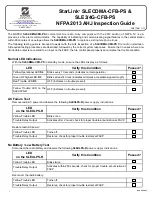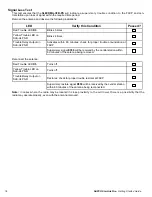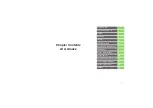
NAPCO StarLink Fire: Getting Started Guide
3
Getting Started...
Which model communicator should I use?
Does your FACP have available standby current of 71mA @ 24V DC ? (must be regulated power supply)
Yes
Select model
SLE-CDMA-FIRE / SLE-GSM-FIRE
(plastic enclosure) or
SLECDMA-CFB / SLE3/4G-CFB
(metal enclosure). These models are powered directly from the 24V DC AUX power provided by the FACP.
This must be regulated power; do not connect to any power outputs designated as "unregulated power". For
your standby power calcs, use 71mA (standby) and 200mA alarm (communicating). Standby backup power for
the communicator is provided by the standby batteries of the FACP during AC power failures.
No
Select
model
SLECDMA-CFB-PS
/
SLE3/4G-CFB-PS
(metal enclosure). These models must be directly
connected to a 120V AC dedicated circuit. Also included are provisions for a rechargeable standby battery.
When would I need a Dual Path model?
Napco offers all StarLink Fire communicator models in both Sole Path and Dual Path versions. The Sole Path models
communicate from the protected premise to the NAPCO NOC through a cellular communicator, while the Dual Path
models communicate through a cellular communicator and/or an integral internet communicator. Note that the StarLink
Fire Dual Path models have an "I" in the part number (indicating Internet). The requirement for Dual Path is typicality
determined by the municipality or the local AHJ.
Note that you may purchase and install a Dual Path communicator model, and select a Sole Path service plan. This
ensures that if Dual path compliance is required in the future, the proper communicator is already in place.
What service plan should I select?
This is typically up to your local AHJ (Authority Having Jurisdiction) who is usually the Fire Marshal of the municipality.
The AHJ will require compliance with a specific version of NFPA72 that will determine the service plan you select. If
unsure of which plan to select, contact your AHJ for guidance.
NFPA 2013
Compliance with NFPA 2013 requires service plans SLF-SVC-13-VZ or SLF-SVC-13-AP, which require
the Fire Communicator to "check-in" to the NOC every 60 minutes to ensure communicator readiness.
This plan is the most common and most municipalities have standardized on 2013. NFPA 2013 service
plans are currently selected for 80% of fire communicator activations nationwide.
NFPA 2010
Compliance with NFPA 2010 requires service plan SLF-SVC-10-VZ or SLF-SVC-10-AP, which requires
the Fire Communicator to "check-in" to the NOC every 5 minutes.
NFPA 2007
Compliance with NFPA 2007 requires service plan SLF-SVC-07-VZ or SLF-SVC-13-AP, which requires
the Fire Communicator to "check-in" to the NOC every 200 seconds.
Summary of Contents for StarLink Connect Series
Page 2: ...2 NAPCO StarLink Fire Getting Started Guide...
Page 4: ...4 NAPCO StarLink Fire Getting Started Guide...
Page 5: ...NAPCO StarLink Fire Getting Started Guide 5...
Page 6: ...6 NAPCO StarLink Fire Getting Started Guide...
Page 7: ...NAPCO StarLink Fire Getting Started Guide 7...
Page 8: ...8 NAPCO StarLink Fire Getting Started Guide...
Page 12: ...12 NAPCO StarLink Fire Getting Started Guide...
Page 26: ...26 NAPCO StarLink Fire Getting Started Guide...
Page 30: ...30 NAPCO StarLink Fire Getting Started Guide...
Page 34: ...34 NAPCO StarLink Fire Getting Started Guide...




































